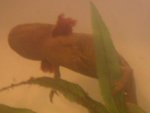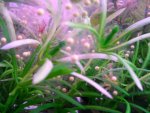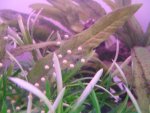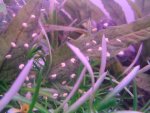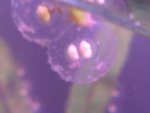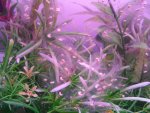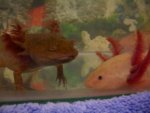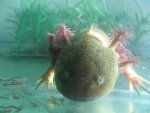Platterpus
New member
- Joined
- Mar 24, 2008
- Messages
- 80
- Reaction score
- 3
- Points
- 0
- Location
- Adelaide, Australia
- Country
- Australia
- Display Name
- Brendan & Kerri
This is very weird…
Last Monday (7th June) I had the thrill of observing one of our olive-brown wild-type axolotls laying a clutch of nearly 400 eggs. She began around 11am and continued laying all day and into the night, carefully attaching each egg to plants, logs and filter. She paused mid-afternoon (exhausted?) and ate several of the freshest eggs, before continuing diligently. I was slightly confused, however, because every egg she laid was pure white - initially suggesting to me that they were infertile (?) – yet I have never heard of an axie actually laying without being fertilized! It would be no surprise to see a small percentage of infertile eggs in a fertile batch – but all 400?!? The oddness of this occurrence compelled me to keep the eggs. On the 4th day, the embryos began to develop!
So begins a series of related questions I am unable to answer…
1) The only male in this tank is leucistic. Even if both parents carry a recessive albino gene (A/a), the average combination could only yield 25% albinos – not 100%. Am I correct?
2) Why did she lay all white eggs? She is mustardy-brown and speckled - definitely NOT albino!
3) Will the babies be all albinos – and if so, why?
4) If not – will pigments develop as the embryos grow? Anyone care to guess what colours?
This seriously undermines the assertion that only albinos (a/a) lay white eggs – I saw it with my own eyes! - and have the photographs to prove it!
Pic#1: Laying – the rear legs carefully positioning the eggs.
Pic#2: A white egg emerging from the cloaca.
Pic#3: A field of white eggs, 24hours old.
Pic#4: Day 4 - the embryos are beginning to change shape.
Pic#5: Tail-budding – Day 5
Pic#6: Twins! Two embryos in a single egg – Day 5
Pic#7: Heads starting to form – Day 6
Pic#8: The proud but bewildered parents
Last Monday (7th June) I had the thrill of observing one of our olive-brown wild-type axolotls laying a clutch of nearly 400 eggs. She began around 11am and continued laying all day and into the night, carefully attaching each egg to plants, logs and filter. She paused mid-afternoon (exhausted?) and ate several of the freshest eggs, before continuing diligently. I was slightly confused, however, because every egg she laid was pure white - initially suggesting to me that they were infertile (?) – yet I have never heard of an axie actually laying without being fertilized! It would be no surprise to see a small percentage of infertile eggs in a fertile batch – but all 400?!? The oddness of this occurrence compelled me to keep the eggs. On the 4th day, the embryos began to develop!
So begins a series of related questions I am unable to answer…
1) The only male in this tank is leucistic. Even if both parents carry a recessive albino gene (A/a), the average combination could only yield 25% albinos – not 100%. Am I correct?
2) Why did she lay all white eggs? She is mustardy-brown and speckled - definitely NOT albino!
3) Will the babies be all albinos – and if so, why?
4) If not – will pigments develop as the embryos grow? Anyone care to guess what colours?
This seriously undermines the assertion that only albinos (a/a) lay white eggs – I saw it with my own eyes! - and have the photographs to prove it!
Pic#1: Laying – the rear legs carefully positioning the eggs.
Pic#2: A white egg emerging from the cloaca.
Pic#3: A field of white eggs, 24hours old.
Pic#4: Day 4 - the embryos are beginning to change shape.
Pic#5: Tail-budding – Day 5
Pic#6: Twins! Two embryos in a single egg – Day 5
Pic#7: Heads starting to form – Day 6
Pic#8: The proud but bewildered parents


